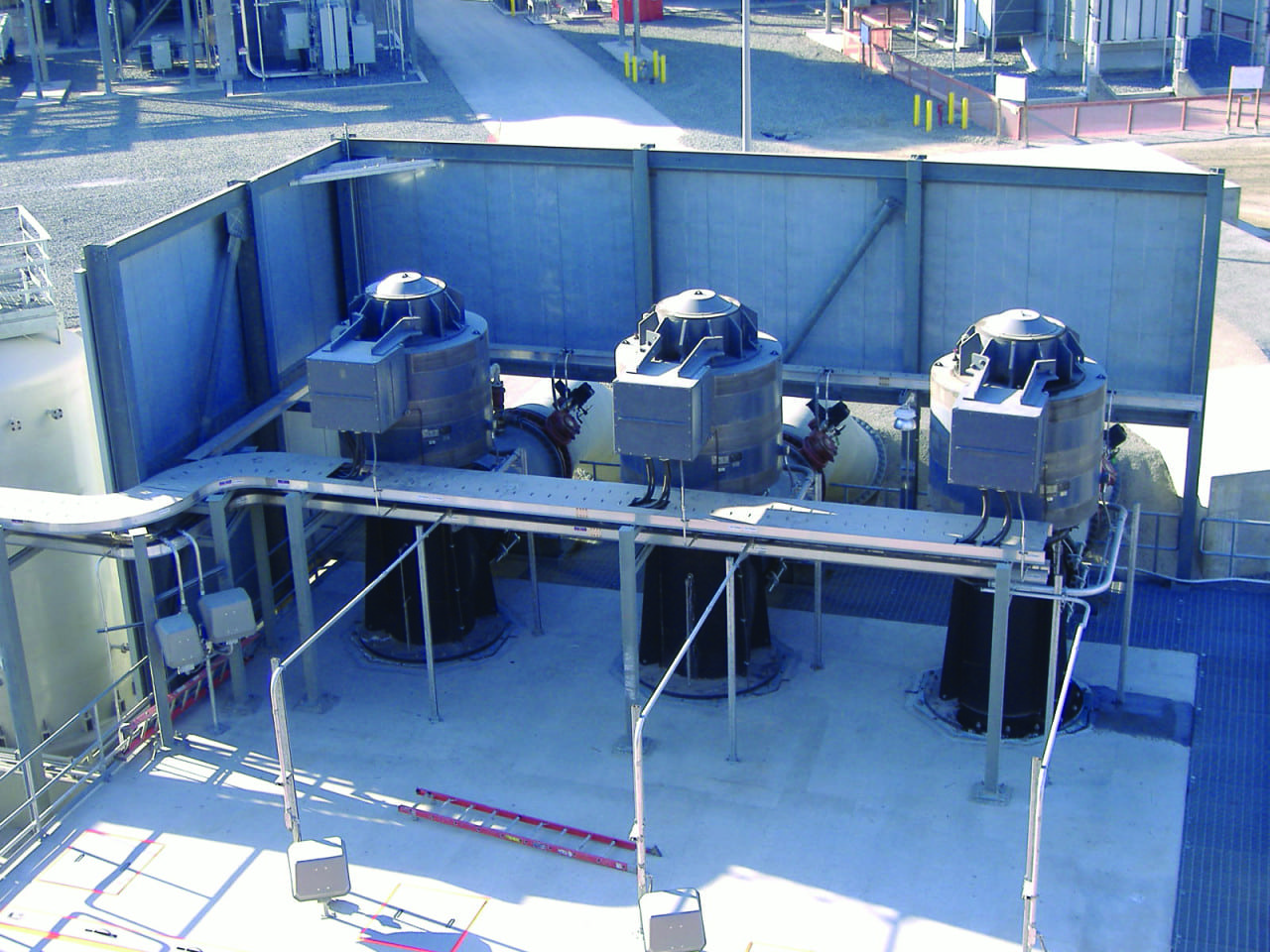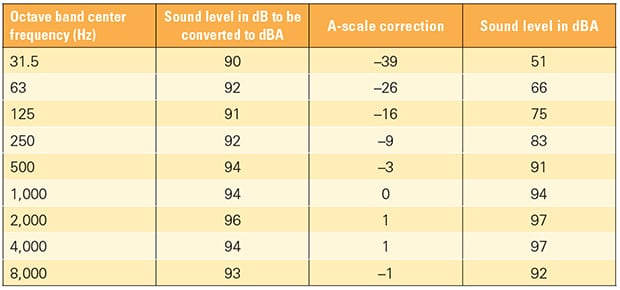SPL = PWL + 10 log [π / (4bc)] + k
where b is the shorter wall dimension (in meters) and c is the larger wall dimension (in meters).
For a point source radiating sound energy in a confined space such as a room:
SPL = PWL + 10 log [Q / (4πd2) + (4 / R)] + k
where R is a room constant. The following equation is used to calculate R:
R = (ST x α) / (1 – α)
where ST is the total area in the receiving room and a is the average sound absorption coefficient in the receiving room. The term 4 / R represents the reverberant field generated by sound reflections from room surfaces. The value of Q could be 1, 2, 4, or 8, depending on structures surrounding the sound power source.
Geometric Spreading of Sound Energy. The geometric spreading of sound energy occurs due to the expansion of sound wave fronts. The geometric spreading could be spherical or cylindrical spreading. Spherical spreading is from a point source radiating sound equally in all directions. In this case, the difference in SPL (in dB) can be calculated using an equation derived from The Engineering Toolbox website as:
∆SPL = SPL2 – SPL1 = 20 log (d2 / d1)
thus, when the distance is doubled the difference in sound pressure level for point source is 6 dB.
In the case of cylindrical spreading, such as noise along a highway or a passing train, the difference in SPL (in dB) is given as:
∆SPL = SPL2 – SPL1 = 10 log (d2 / d1)
thus, when the distance is doubled the difference in sound pressure level for a line source is 3 dB.
Sound Barriers and Insertion Loss. The SPL-distance equations given in the section above are valid provided there is no sound barrier (such as a solid wall structure) in the direct sound path from the source to the receiver. If a sound barrier is present then the insertion loss (that is, noise attenuation) due to the sound barrier must be considered (Figure 2).
 |
| 2. Sound barrier. Noise barriers were installed around the vertical pumps shown here to reduce noise levels in the surrounding area. Courtesy: Bechtel Corp. |
To calculate the insertion loss, first calculate the direct path length (d) between the source and receiver. Then, calculate the extended path length between the source and receiver due to the sound barrier. In the case of a solid wall, the extended path length would go from source to the top of the wall (distance A) and then down to the receiver (distance B). The path length difference (A + B – d) is then used to find the insertion loss from Table 3.
Noise Calculations for Building Service Equipment
As an example, consider the noise generated by an in-duct fan supplying atmospheric air through a single outlet diffuser in a room within a building. The SPL in the room reaching the observer’s ear is the logarithmic sum of the direct SPL and the reverberant SPL.
The details for calculating the SPL reaching the observer’s ear are as follows:
1. Use the fan manufacturers’ SPL noise spectrum across the various frequencies as the starting point.
2. Analyze the duct system between the fan and the room diffuser outlet, and evaluate the duct attenuation based on straight runs and duct bends.
3. At low frequencies, the sound power reaching the outlet diffuser is partly reflected back in the duct. This is the outlet reflection effect, which provides some degree of attenuation. The values for the outlet reflection effect are available in literature and are based on the area of the outlet diffuser.
4. Total duct attenuation is therefore the sum of #2 and #3 above.
5. Total SPL leaving the system can then be evaluated by subtracting #4 from #1.
6. The SPL values in #5 then need to be adjusted for the following three factors:
- ■ Percent of total fan airflow leaving the room outlet (5%, for example)
- ■ Distance from the outlet to observer (1 to 2 meters, for example)
- ■ Directivity, which is based on the location of the outlet with respect to corners and walls.
The effect of the first two adjustments is an SPL decrease, whereas the third factor tends to increase the value.
7. The adjusted value calculated in #6 is the direct SPL.
The next step is to calculate the reverberant SPL, which is done as follows:
1. Sum the impact of reverberant factors from the percentage of fan air volume serving the room under analysis; the room volume factor, which accounts for reflection/absorption of sound in the room; and the reverberation time factor.
2. The reverberant SPL can then be calculated as the sum of SPL leaving the system and the impact of reverberant factors. That is, adding #5 from the direct SPL analysis and #1 above.
3. Finally, the combined SPL can be calculated as the logarithmic sum of direct SPL and the reverberant SPL. That is, using #7 from the direct SPL analysis and #2 above.
The combined SPL established above can then be compared with the design basis noise criteria to determine if further attenuators are required. In some cases, sound levels in a room may be affected by duct breakout (sound energy escaping through the walls of a duct passing near an occupied space that does not serve that area). However, based on a paper published by Trox Technik titled “Sound and Sense,” noise due to duct breakout can be mitigated by limiting duct attenuation to 15 dB.
Vibrations and Ground-Borne Noise
Vibration levels (in decibels, VdB) are defined using the following equation, found in Fundamentals of Acoustics by J. Paul Guyer of Continuing Education and Development Inc.:
VdB = 10 log (v1 / vref)2
where v1 / vref is the ratio of the velocity amplitude with v1 as the root mean square of the velocity amplitude (in meters/second) and vref as the reference expressed in velocity units such as 5 x 10–8 meters per second. (Reference values may vary when using U.S. units.)
Rotating machinery, vehicles, and trains excite the ground and generate waves that propagate through the soil to the foundations of nearby buildings. The foundations propagate the waves to room structures. The rumble often heard is noise from the movement of building room walls, floors, and ceilings, and the threshold for human perception of ground-borne noise is around 65 VdB.
The unweighted SPL is approximately equal to the average vibrational velocity level of the room surfaces (assuming a room with average acoustical absorption). The A-weighting correction at 30 Hz is approximately –40 dB and at 60 Hz is –25 dB. Accordingly, if the vibration velocity level peaks at 30 Hz, the ground-borne noise level is 65 – 40 = 25 dBA, and if it peaks at 60 Hz, the ground-borne noise level is 65 – 25 = 40 dBA. ■
—S. Zaheer Akhtar, PE is principal engineer with Bechtel Corp. Thanks to Henrik Olsen, senior noise and vibration specialist with Bechtel Corp. for reviewing and providing valuable comments.



